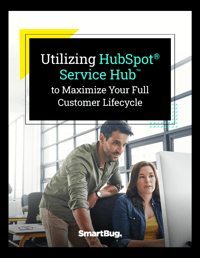
Shifting from Zendesk to HubSpot is a strategic move for businesses aiming to unify their operations across sales, marketing, and customer service. The most common motivators for a system migration from Zendesk to HubSpot are the improved integration, functionality, and support capabilities.
Though beneficial, this transition demands careful planning and execution. It also necessitates thorough training to fully harness HubSpot's capabilities. A smooth shift enables businesses to improve customer engagement and operational efficiency.
By undertaking this change, companies are evolving their approach to connect with their audience and accelerate growth. Here are some best practices to get you started.
Evaluate Your Current Zendesk Configuration
When preparing for a Zendesk HubSpot integration, it's crucial to embark on a thorough evaluation of your current Zendesk configuration and set clear, strategic goals for the migration. The following cohesive approach integrates insights and best practices gleaned from extensive industry experience.1. Analyze Your Current Situation
Start with a comprehensive analysis of your existing Zendesk setup. This involves identifying all customer data fields, business processes managed through Zendesk (such as ticketing and issue resolution workflows), integrations, and customer service protocols (such as ticket escalation policies). It’s essential to not only highlight what's working well but also pinpoint areas for improvement or customization that have been vital for your operations.Once you've mapped out the active fields and processes, evaluate the quality of your data. Are there redundant fields or outdated information that shouldn't be migrated?
Finally, assess the following to ensure a similar or improved structure can be implemented in HubSpot:
- Workflows
- Automations
- User roles and permissions
2. Set Transition Goals
Defining why you are moving to HubSpot is fundamental. Whether it's for enhanced customer relationship management (CRM) features, superior integration capabilities, or more robust customer engagement tools, your objectives should be clear and well defined.
One of the top reasons customers do a system migration from Zendesk to HubSpot is that they are looking to unify their marketing, sales, and customer support data. Zendesk is natively a ticketing and knowledge base platform. Though there are other Zendesk modules that offer CRM-like capabilities, most customers choose to integrate with other CRM systems, such as HubSpot or Salesforce.
Set measurable criteria for evaluating the success of the migration, prioritizing various data fields and processes based on their importance to your operation. This helps create a focused blueprint for the migration process, ensuring that your move to HubSpot aligns perfectly with your business needs and goals.
Migration Planning Insights and Best Practices
A smooth migration also involves cleaning up data before the move. Eliminate invalid emails, resolve unassigned ticket conversations, duplicate contacts, or purge contacts with no ticket history to ensure the data you move is accurate and useful. Setting up your new environment in HubSpot requires configuring custom fields, adding agents, setting up integrations, and ensuring any macros or automations are properly transferred and adapted to the new system.
Timing your switch accurately is crucial to avoid data loss and ensure continuity in customer communication. Establish a cutoff date for your old system and make sure all new customer interactions are directed to your new HubSpot environment from that point forward.
Keep in mind that this is not a one-size-fits all process. It’s OK to launch in phases. If you have a complex support system or process, you may want to stagger the launch by specific segments or types of inquiry.
Tailoring HubSpot to Your Business Needs
A system migration from Zendesk to HubSpot for service use cases involves leveraging HubSpot's customization capabilities to ensure a seamless transition and enhanced customer service experience.Here's how to tailor HubSpot for such scenarios:
Ticketing System Customization
HubSpot allows you to customize ticket properties based on specific service requirements. You can create custom fields to track unique aspects of service inquiries, such as issue severity, product version, or customer satisfaction scores, ensuring a more tailored response to each customer's needs.Automated Workflows
Utilize HubSpot's workflow automation to streamline service operations. Set up automatic ticket routing based on criteria such as issue type or customer tier, ensuring that high-priority or specialized issues are quickly directed to the appropriate team members. Automate follow-up emails for case updates or satisfaction surveys to maintain communication and gather feedback efficiently.Knowledge Base Integration
Transition your Zendesk help center to HubSpot's knowledge base, customizing it to match your branding and organizing articles for easy navigation. Leverage HubSpot's SEO recommendations to ensure your help articles are easily discoverable, reducing the volume of incoming service tickets by empowering customers to find answers themselves.Service Dashboard Customization
Tailor your HubSpot service dashboard to monitor key performance indicators (KPIs) crucial to your business, such as:- Ticket resolution times
- Customer satisfaction scores
- Agent performance metrics
This allows for real-time monitoring and data-driven decisions to continuously improve service quality.
Live Chat and Bots
Implement HubSpot’s live chat and chatbot functionalities to offer immediate assistance on your website. Customize chatbots to handle common inquiries or guide users through troubleshooting steps, reserving live agent interaction for more complex issues. This not only improves response times but also enhances the overall customer service experience.
By customizing HubSpot around these key areas, companies moving from Zendesk can create a powerful, efficient, and customer-centric service operation that leverages HubSpot's full suite of features tailored to their specific needs.
Setting Up Ticketing Systems and Service-Level Agreements (SLAs)
Similarly, the ability to set up tailored ticketing systems and define SLAs ensures that customer service operations are streamlined and efficient. Consider a tech company that offers varying levels of support based on customer tiers. By customizing ticketing workflows and SLAs in HubSpot, the company can prioritize tickets from premium customers, ensuring they're resolved within the promised time frame, thereby enhancing customer satisfaction and loyalty.
Data Migration and Mapping
Migrating and mapping data from Zendesk to HubSpot is a critical step that requires meticulous planning. It involves transferring not just contact information but also detailed support tickets and interaction histories. This comprehensive migration ensures that all customer interactions are accessible within HubSpot, providing a complete view of the customer journey. For example, when a sales rep looks up a customer, they can see not only previous purchases but also any support issues the customer has experienced, enabling a more informed and personalized interaction.
Integrating Essential Tools and Applications
The seamless integration of tools and applications is vital for maintaining operational continuity and enhancing functionality. HubSpot's marketplace is replete with integrations across email marketing, lead generation, accounting, and more, enabling businesses to create a tech stack that perfectly suits their needs. For instance, HubSpot has built-in data sync to allow for automating workflows between HubSpot and hundreds of other applications, streamlining processes and saving valuable time.
Customizing Dashboards and Reporting Tools
Customizing HubSpot’s dashboards and reporting tools is crucial for monitoring key metrics and driving business success. Businesses can create custom dashboards to track the metrics that matter most to them, whether it's website traffic, lead conversion rates, or customer service response times.
For example, a senior living community can leverage these tools to streamline resident inquiries and service requests, ensuring a high level of care and responsiveness. By creating dashboards specifically tailored to monitor and analyze resident interactions, such as frequency of requests, types of inquiries (e.g., maintenance, dietary, activity scheduling), and response times, community management can identify trends and areas for improvement.
This data-driven approach allows for the optimization of staffing levels, the prioritization of service enhancements, and the personalization of resident communication, ultimately leading to increased satisfaction and a stronger sense of community among residents.
Training and Onboarding to HubSpot Service Hub
A system migration from Zendesk to HubSpot might feel daunting, but you’re not alone. There are plenty of resources out there to help you through the process. From free online training to on-site and virtual expert sessions tailored just for you, there’s an option for everyone.
SmartBug’s Free Training
See all future and past Zendesk-related events, including LinkedIn Live events, such as “Zendesk vs. HubSpots Service Hub,” “How to Measure Retention Using HubSpot Service Hub,” and more.
On-Site or Virtual Training
Accelerate your onboarding to HubSpot Service Hub with SmartBug Media's tailored training sessions. These workshops are designed for sales, marketing, and customer success professionals eager to maximize Service Hub’s features. Participants will learn to configure the help desk and ticketing system, build a knowledge base, monitor and configure live chat, and analyze customer survey tools, ensuring a seamless transition and efficient use of the platform for superior customer service.
HubSpot’s Educational Resources
Encourage your team to engage with HubSpot Academy’s free Service Hub software course. These resources are invaluable for understanding how to maximize the platform's potential.
Develop tailored training programs that address specific use cases and operational workflows within your organization. Practical, hands-on sessions can facilitate a smoother transition.
Feedback and Continuous Learning
Establish a feedback loop to identify any challenges or gaps in knowledge as your team transitions to HubSpot. Use this feedback to adjust training and support mechanisms.
Implementing the Migration—and Beyond
Choosing the right migration tools and partners is critical. Whether it's simple data transfer methods or more complex migration needs requiring specialized extract, transform, and load tools, the focus should be on compatibility, data integrity, and minimal disruption to your operations. Ensure that your team is well prepared with a detailed migration plan and clear communication channels established to facilitate smooth collaboration throughout the process.
There are three ways to approach the migration process.
1. Engage an expert partner like SmartBug. A great partner provides peace of mind with a timely and thorough migration process that includes the following:
- Pre-migration analysis
- Project management
- Service Hub training
- System integrations
- Migration of macros and historical conversations
- Post-launch support
Learn more about SmartBug’s system migration solutions from Zendesk to HubSpot →
2. Use a third-party, DIY migration tool. Proceed with caution; these tools typically don’t include any of the above services, and there is a real risk for loss of data.
Availability of post-launch support varies by tool.
3. Use HubSpot CSV Importer or another self-service tool. HubSpot’s importer is a useful tool but does not provide the expert pre-migration analysis, planning, or training needed for successful continuity (and improvement) of service processes.
Monitoring performance and continuous optimization also play crucial roles in the successful transition to HubSpot from Zendesk. It starts with defining clear KPIs, such as operational efficiency metrics, customer engagement scores, and conversion rates. These KPIs are vital for measuring the impact of migrating to HubSpot on both business operations and customer interactions. Consistently evaluating these indicators is essential for understanding current performance and pinpointing areas in need of improvement or refinement.
Adapting to new insights is a continuous necessity for businesses. HubSpot frequently updates its platform with new features, so staying abreast of these changes and revisiting configurations can reveal additional optimization opportunities. This proactive approach ensures that your business can leverage the latest functionalities to enhance both processes and customer engagement.
Maximize the Benefits of HubSpot
A system migration from Zendesk to HubSpot represents a significant opportunity to improve how your business interacts with customers and streamlines internal processes. With careful planning, customizing the HubSpot platform to suit specific business needs, and thorough team training, the transition can be smooth and successful. Moreover, this migration journey is an ongoing process of learning and optimization aimed at fully utilizing what HubSpot offers.
Businesses interested in deepening their understanding and maximizing the benefits of switching from Zendesk to HubSpot are encouraged to visit our system migration solutions services from Zendesk to HubSpot page. This resource is rich with information and support designed to navigate you through your migration, helping to ensure you harness the full power of your new HubSpot environment.

About the author
Sara Wolfe Vaughan was formerly a demand generation strategist from Arizona. As a former non-profit professional with an MFA in creative writing, she has worn many hats from full digital strategy development to game-changing capital campaigns. Her focus is on helping clients build lasting relationships with their customers. Read more articles by Sara Wolfe Vaughan.







-2.png?width=800&length=800&name=Blog%20header%20image%20(1)-2.png)